This is probably THE golden opportunity to grasp the real truth behind these three letters of doom.
Over the past few weeks there have been four actual examples where Eric units have been recently installed on new Koi ponds.
Mark Miller installed an E3 unit in Essex.
His brother Steven Miller installed two E4 units, again in Essex.
Susan Campbell started up an E4 unit in Montpelier, France.
Sam51 installed an E3 unit in Holland.
Mark, Steve and Sam have known all about NPS through other filter systems they have used but in Susan’s case, this is her very first Koi pond.
Here are some of their comments posted on ‘Them There Koyas‘ forum – I have highlighted the important parts in red.
Re: C’mon, E owners, out with the truth!
Not new pond .Complete new filter system..Bead and nexus removed in the last couple of months .Matured a couple of filters in my time , but im finding the eric totally different . Begining to see a pattern emerging here ,could be wrong im no expert in such matters..Normally you get a little ammonia ,which you keep check on until a nitrite spike.Then normally keep feeding lightly and they both seam to adjust and lower .Then increase feed and carry out the same procedure ,building up your biological..Im finding that the ammonia is being dealt with by the eric so much more efficiently that nitrite is creeping up very fast .Can only hope that once the bacteria that deals with nitrite takes hold filteration will be at a new level ..Used to get ammonia when maturing old filters just hang about for days.. Pond 2400gal 80ltr filter 40 on drain,richdon ventui on skimmer returned by waterfall for air.
i cant dump both mine as it empties the pond lol i dump the brushbox sections everyday…both and one whole box every third day,as im not feeding much
i will monitor the situation,and adapt to suit
i can see myself dumping one eric each day and both brushboxes
i too have nitrite,it dosnt make sense, the koi are very hungary,swimming up and down the pond in the upper layers claritys very good,with my cheap carp pellets
the koyas seem fine still lol in the past a 0.25 read would upset them today i got a 1.0 read!
ive tested the mains water..nothing there tested for leeching on pipework supplying the trickle..nothing there i refuse to accept this is a true read..!
The best laid plans of mice and Koi keepers…. I did my usual Tetra strip test a few minutes ago, and nitrite readings were suddenly at the high end! Petah told me to get my … in gear and get proper testing equipment for more accurate readings. I will do this this afternoon, as the shops are closed on Monday mornings over here. The Koi don’t seem to give a damn, just stuff their faces and swim around as usual. But still…a water change seems to be on the order of the day’s activities.
suzy
so with my readings, and the way the fish are behaving, i have given up testing the water now.my fish should be doing what you say.
sam51
brasso
its marks fault..lol
i used to test all the time ,but these days i just go by the koi
i repeat they appear fine
lets face it ,im a bit of a noddy,most of us are ,when things go wrong
we piss in the wind..!
ive always trusted the api kit,ill go get myself another kit,well mark can get it
and ill borrow some lol
ammonia is still 0
thanks dan and usually you would be right this is different i applied the usual,feed ,get reads,back off,feed routine and usually the koi would tell you if you over did it i think it took two weeks to get a small spike in ammonia,then some eight days from memory to obtain nitrite within three weeks readings were flatlining this is different..! the koi are gagging,compared with the water temps the koyas should be showing signs of illness/stress its like there on acid lol this is s first filter she hasnt experienced the difference the nitrite readings shes had …well…. im making myself look a right pratt by bringing it up this really is a bit different if i was reading this id be saying STOP feeding you pratt
In a nutshell, what all four are reporting and questioning is –
- 1. They all have never had any real ammonia readings and wonder why?
- 2. They ALL have ridiculously high and so-called ‘lethal’ nitrite readings.
- 3. Their Koi live in these so-called ‘lethal’ readings totally unaffected by them.
In short, they are all wondering exactly why NPS has passed them by when using Eric units?
OK, I’m going to explain exactly why, knowing full well the explanation will also offend and rile many out there.
There will also be others who will not exactly relish reading it – but I’m also equally sure there will be many others who will thank me profusely for it and they are the ones who really matter after all.
NPS is simply a myth handed down from aquarium technology; it’s an abbreviation for ‘New Pond Syndrome’.
This describes a period between where a pond is started up for the first time and the time it takes for the biological filter stage to ‘mature’.
All newcomers are warned well in advance that there will be nightmare readings of both ammonia and nitrite in the pond water which are positively dangerous to the Koi in the pond if these readings are allowed to continue.
So they are then given instructions as to how to dilute these harmful effects by reducing feeding and changing huge volumes of water.
Talk to those who have experienced it all and they’ll confirm it can last for weeks or even months on end and some will also describe how many Koi were damaged or even lost directly because of the dreaded NPS.
NPS does exist but it’s not an abbreviation for New Pond Syndrome – it’s an abbreviation for ‘NAFF PHILTER SYSTEM’ and it’s about time the myth is exposed for what it is.
Here are some of the most popular filter systems that are all guilty in producing these nightmare water conditions –
1. These units are known as bead filters and the manufacturers would have us believe that the arrows shown denote how they operate to supply incoming water to the bead media.
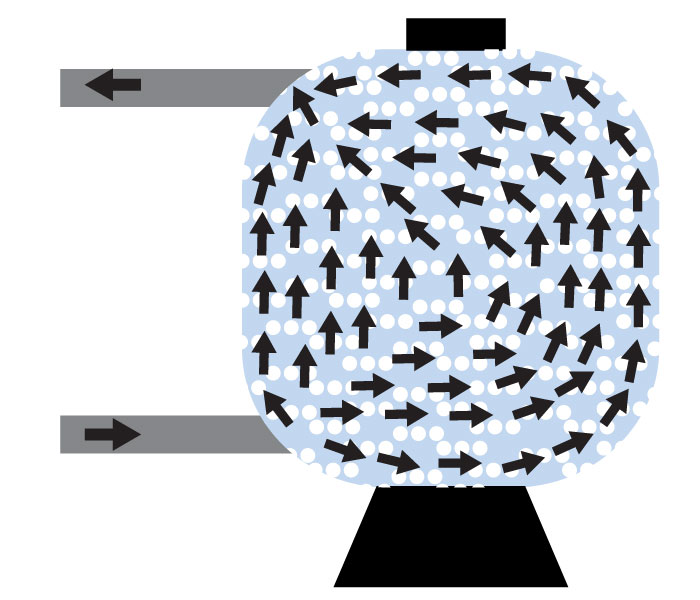
When in truth, this is what’s taking place. Pumped water doesn’t ‘bend around curves’ it takes the shortest route to the exit and that’s a straight line. The water in the curved areas went in on the first fill and that’s where it will stay until the unit is drained.
![]()
2. These are square, rectangular or circular single chamber or multi-chamber boxes that hold a static media such as filter mat cartridges. And the arrows shown is how the manufacturer thinks they operate in getting incoming water to the media surfaces.
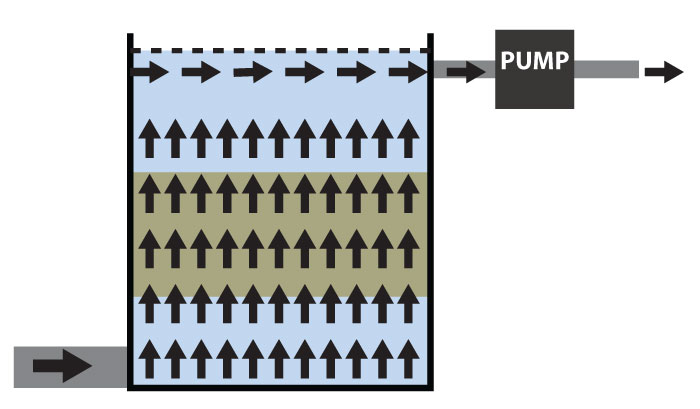
When in truth, this is what’s actually taking place – either by pump or by gravity. Water rises evenly on first fill but doesn’t ‘hang a left 90 degree angle’ or ‘hang a right 90 degree angle’ when it reaches the surface in order to get to the exit! Again, the water surrounding the tracking line went in there on first fill and will remain there until the box is drained.
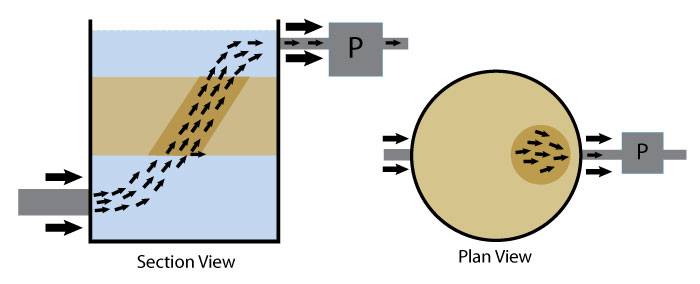
3. These boxes are identical to those in 2 above but instead of static media these are filled with moving media driven around by aeration. Once again the arrows denote how the manufacturer thinks they operate in getting incoming water to the media surfaces.
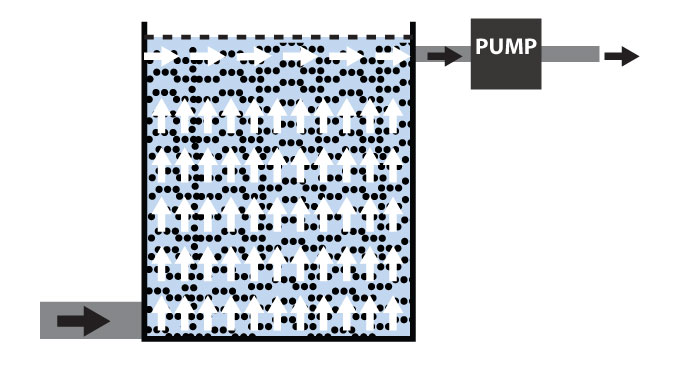
When in truth, this is what’s actually taking place – again, either by pump or by gravity. Andy
In these three most-popular examples, the water tracks directly from inlet to outlet as it must do in any upward-flow box and the amount of media surfaces it actually ‘contacts’ on its travels is precious little when compared to the amount of media that’s actually inside the boxes.
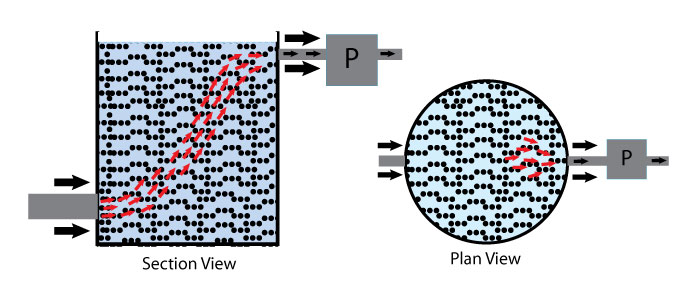
All three examples are little more than useless in getting the incoming toxic pond water into contact with any more than the smallest area of media surfaces but 1 and 2 at least have a static area that the tracked water passes through.
This is not the case in 3 where random pieces of media pass through the tracked water only very occasionally before being dragged into areas of dead water – think about it!
Now, whether the reader wishes to thank me or wishes to crucify me for mentioning all of this means little to me, but the reasons as to why the myth that is NPS takes place in these boxes is simply because there’s so little actual media contact with the water passing through.
As a result it takes an ‘age’ for any real signs of a biomass large enough to mature the pond water and when it finally does, it’s destined to be always balanced on a knife-edge – especially in times when medications need to be added!!
But DO heed the warnings given regarding NPS because high ammonia readings in the water that are allowed to continue unchecked are extremely dangerous to the Koi in the pond.
Now check back to those who are making the comments at the start of this article and ask yourself why there’s not one single mention of NPS there?
There’s no mention of it because, in those boxes, it doesn’t happen – ever.
And the reason for this is simply due to the total coverage of ALL media surfaces by the incoming water – right from the very moment the filter system is started up, after this it is in permanent contact.
Water temperatures do play a part in just how quickly it takes for the first brief blip of ammonia to come and go – and it does – but there are very few Eric owners who actually witness it!
And the Nitrite readings?
Oh yes, there’s plenty of that as you can see from the comments and some of the levels of 2.0 are said by many out there to be positively lethal to our Koi.
Even levels of a mere 0.3 are said by some to be absolutely intolerable for our Koi.
Check the posts above again – carefully.
Even at a howling 2.0 nitrite content, the Koi in these ponds don’t even notice it – they don’t scratch, they don’t jump, they don’t sulk and they don’t die – they just carry on feeding and then go looking for more!
A reminder – it’s 2012 right now; I reckon it’s about time we woke up to reality!
Waddy 09/05/12.
Footnote.
I watched all the postings made on these matters as they were actually happening and also knew the outcome well in advance from previous installations.
Had there been any concerns on my part regarding ANY problems along the way I’d have contacted the owners immediately – be assured, there were no problems – only superstitions and fears resulting from flawed and hopelessly outdated bad advice.



